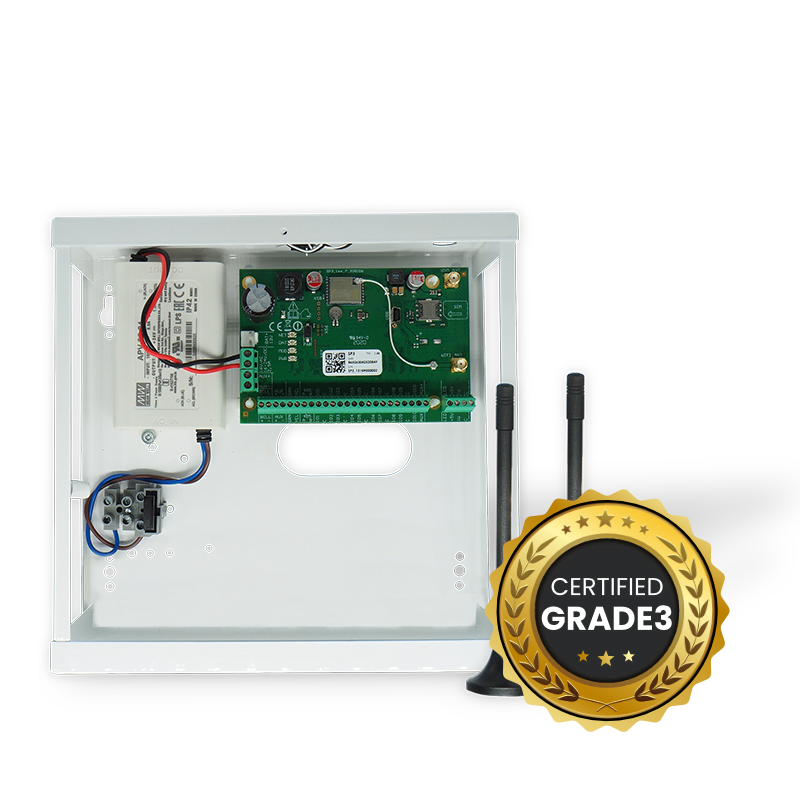Description
Features
Reporting to the security company‘s central monitoring station (CMS):
- Event reporting either via the built-in WiFi module or cellular 2G/4G modem.
- Additional modules to send reports via Ethernet or VHF/UHF radio waves with chosen priority.
- Any CMS can receive reports, as long as they have TRIKDIS software/IP receiver or any other manufacturer’s IP receiver supporting SIA DC-09 IP protocol.
- Design based on two decades of experience in transmitting reports to main and backup central monitoring station receivers, which allows security companies to provide the highest level of protection to premises
- A setting for the necessity to send to CMS, to mandatorily send reports to CMS first, and only then to customers.
- Possibility to send event reports to CMS of two different security companies.
- Multitude number of message transmission channels and multiple transmission priority settings.
Reporting to user:
- Via Protegus mobile app, which gives warnings about alarm system events using push and special sound notifications.
- Event reporting via SMS messages to 8 cellular numbers.
- Reporting about events using pre-recorded voice notifications (up to 8 cellular numbers).
- Remote control of selected premises’ protection mode (Arm/Disarm/Stay/Sleep).
- Remote control of connected devices (lighting system, automatic gates, ventilation, heating, watering systems, etc.).
- Remote temperature measuring.
Inputs and outputs:
- 10 I/O terminals, each one can be set as an input (IN) or output (OUT). Input (IN) types: ATZ, EOL, NC, NO. Different parameters of resistors can be used in EOL and ATZ type circuits. The number of inputs IN can be expanded to 32 by using keypads, iO-8, and iO-WL expander modules.
- The board has 2 dedicated outputs: the bell and the LED. The bell is to control the siren, and the LED is to control indicator lights. The number of outputs can be expanded to 16 by using iO-8 and iO-WL expander modules.
- Seven output operational settings. Each output can be assigned with an operational logic, a preset operation schedule, or qualities, for example, thermostat mode.
- One-wire data bus (“1-Wire”) is designated to connect temperature sensors (up to 8), a temperature and humidity sensor (1), or a key fob (“iButton”) reader.
- The GRN-YEL data bus is designated to connect 8 keypads of the same type.
- The RS485 data bus connects iO series expander modules: RF-SH radio wave wireless sensor transceiver, E485 Ethernet module, T16 VHF, or UHF radio wave transmitter.
Control of alarm system
- 4-digit long control codes (40 in total), which may be used as a coercion code as well. In such a scenario, entering the user code will disarm the alarm, yet a special report will be sent to the CMS indicating that the alarm was disarmed as a result of coercion.
- Control using keypads: SK232LED, Paradox K636, K10H(V) K32+LED, K32LED, K35, Crow keypad CR16, CR-LCD, CZ-Dallas electronic (“iButton”) key reader, TM17 electronic key reader, RFID reader (Wiegand 26/34).
- Remote control via Protegus mobile app, phone call, or SMS.
Simple installation:
- Multiple sizes of SP3 mounting kits that include a decorative white metal housing with a built-in step-down transformer or impulse power supply.
- Default SP3 operational settings are based on many years of experience. That allows us to install the system in 7 out of 10 small and medium-sized premises without the need to change the default settings.
- The SP3 control panel allows us to replace the previous panel without changing the resistors in each wired sensor.
- Settings can be saved as a file to be used later.
- Device configuration via USB cable or remotely by using TrikdisConfig
- Remote connection via TrikdisConfig software allows not only altering SP3 parameters but monitoring the operation of the panel as well.
- Two access levels for parameter settings: installer and administrator.



A –
The best Trikdis product so far. A lot of functionality and features.